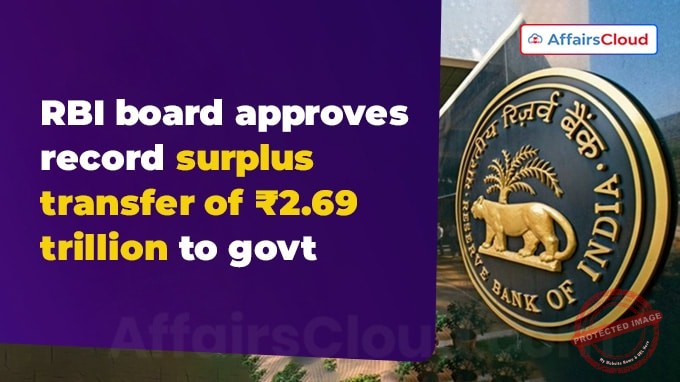 In May 2025, the 615th meeting of the Central Board of Directors of Reserve Bank of India (RBI) meeting under the chairmanship of RBI Governor Sanjay Malhotra was held in Mumbai (Maharashtra). The Central Board has approved the transfer of Rs 2,68,590.07 crore (Rs 2.69 trillion) as surplus to the Government of India (GoI) for the Financial Year 2024-25 (FY25). This is 27% higher than surplus transferred in FY24 (Rs 2.11 trillion).
In May 2025, the 615th meeting of the Central Board of Directors of Reserve Bank of India (RBI) meeting under the chairmanship of RBI Governor Sanjay Malhotra was held in Mumbai (Maharashtra). The Central Board has approved the transfer of Rs 2,68,590.07 crore (Rs 2.69 trillion) as surplus to the Government of India (GoI) for the Financial Year 2024-25 (FY25). This is 27% higher than surplus transferred in FY24 (Rs 2.11 trillion).
- The significant surplus is largely driven by strong earnings from foreign exchange operations, with gross dollar sales surging to USD 399 billion in FY25, more than double the USD153 billion recorded in FY24.
- Also, this payout for FY25 is marginally higher than the GoI’s budgeted estimate of Rs 2.56 trillion. However, it is lower than some of the market estimates of Rs 2.7-4 trillion for FY25.
- The Central Board has decided to increase the Contingency Risk Buffer (CRB) to 7.50%, the highest end of the new band, based on revised ECF.
Note: RBI transfers the surplus, in accordance with Section 47 (Allocation of Surplus Profits) of the RBI Act, 1934.
Key Points:
i.The surplus transfer for FY25 was calculated as per the revised Economic Capital Framework (ECF), that was approved by the Central Board in its meeting on May 15, 2025.
ii.This dividend is expected to reduce the Fiscal Deficit(FD) of the government by nearly 20 basis points (bps) from the budgeted level of 4.4% of Gross Domestic Product (GDP).
ii.As per revised ECF, RBI has expanded the buffer range of CRB range from the earlier 5.5–6.5% of the balance sheet, maintained over the past five years (2019–2024), to a broader 4.5–7.5% range, effectively setting it at 6% with a flexibility of ±1.5%.
- For FY25, the buffer has been set at 7.5%, marking the upper limit of the newly revised range.
iii.The Central Board with respect to the Surplus Distribution Policy has observed if the Available Realised Equity (ARE), which is a total of capital, reserve fund, contingency fund and asset development fund, is more than 7.5% of balance sheet size, then it may be written back from the Contingency Fund to income.
- If ARE is lower than 4.5%, no surplus will be transferred to the GoI until the minimum level of Required Realised Equity is achieved.
- As per RBI, the ARE was Rs 4.58 trillion(6.5% of the balance sheet) in FY24.
About Economic Capital Framework (ECF):
i.The surplus transfer for any accounting year by RBI, is determined by the Economic Capital Framework (ECF) adopted by RBI (in 2019), based on the recommendations from the Expert Committee chaired by Dr. Bimal Jalan, former RBI’s Governor.
ii.The existing ECF was reviewed after 5 years as mandated by the Jalan Committee.
iii.During the accounting years from 2018-19 to 2021-22, due to the macroeconomic conditions and the onslaught of COVID-19 pandemic, the Central Board had decided to maintain the CRB at 5.50% of its balance sheet to support growth and overall economic activity.
- The CRB was further increased to 6.0% for FY23 and to 6.50% for FY24.
Important Term:
i.Contingency Risk Buffer (CRB): It is a percentage of RBI’s profits that acts as a buffer against Non-Performing Assets (NPAs) or bad loans, declining asset values, staff costs, or unexpected economic shocks.
ii.Contingency Fund :The Contingency Fund refers to a reserve maintained by governments or central banks to meet unexpected or emergency expenditures that are not budgeted for in advance.
Recent Related News:
In April 2025, Mumbai (Maharashtra)-based RBI has issued revised directions regarding the opening and operation in the deposit accounts of minors. As per RBI directions, minors above the age 10 are now allowed to open and operate their own savings as well as term deposit accounts independently, subject to limits and terms defined by individual banks. These directions came into force from April 21, 2025.




